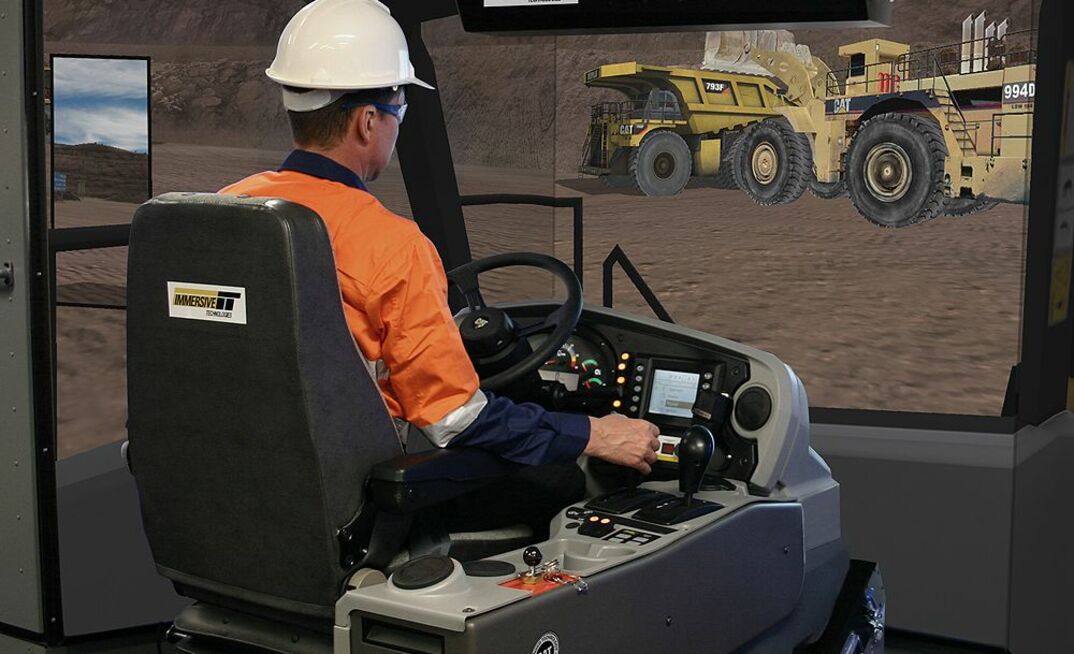When times were booming, many miners bought training simulators.
These machines, for which there is often little change out of $A1 million, can be configured to simulate just about any machine the mine may have – in some cases down to the light vehicles.
They usually come as a motion base – which provides the movement in at least three degrees of motion – that simulates the piece of machinery in operation and with various housings that sit over the motion base and mimic the cabs of the machines being simulated.
Sitting in one is a lot like operating the machine, even down to the vibrations of the diesel engine at idle.
Most of the major simulator makers can even create a mine simulation that matches the operation the simulator is being used at.
The main players in the simulator game are Immersive Technologies, Thoroughtec, Fifth Dimension Technologies and CAE.
One thing they have been touting is the ability for their systems to improve the productivity of operators.
According to research by Caterpillar, a 5% improvement in operator efficiency leads to a 5% increase in productivity. There is no other one-to-one improvement ratio available in the industry.
So if this productivity improvement technology has been available for some time now – years in fact – why is productivity slipping?
It comes down to the imperatives facing mining operations.
From 2005 until quite recently the imperative was to find enough operators to do the mining work.
Employee turnover was also quite high.
Immersive Technologies executive vice-president – sales and support David Anderson said in many cases companies had a turnover rate of 20%-30% while they were trying to grow their operations at 20%-30%.
That is a net effect of up to 60%.
Therefore the simulators were not used for operator improvement. They were used to get operators just competent enough to operate the machines safely.
“We had a lot of satisfied customers that were using our simulators for 30 to 40% of their potential,” Anderson said.
That has changed. These days it is all about getting the biggest bang for every production buck.
“The simulators are not necessarily being used more or less than they used to be,” Anderson said.
“But the focus of the training has changed.
“Previously 80%, say, may have been more on induction and operator readiness. Now it’s shifting to the improvement of existing operators.”
Anderson said Immersive had a user group get-together a month ago. There were 10 customer presentations and nine of those focused specifically on their business improvement results.
All of those presentations came back in some way to a business improvement agenda.
Anderson said the machines Immersive was offering to the market could help measure an operator’s performance to help them improve.
He said the company was becoming involved with business improvement projects on mines using those measurement tools.
This can involve comparing the simulator metrics on operator performance on the simulator with the vehicle information management system data from the vehicles they operate.
Such data from the original equipment manufacturer systems will show whether an operator is being hard on a machine, either accelerating or braking excessively or incorrectly.
Immersive has set up its simulator outputs to match with the OEM VIMS data.
Any discrepancies identified give areas to be worked on.
“We’re putting the operators through change management programs,” Anderson said.
“The can involve a curriculum in the classroom or e-learning sometimes. We can then test the operators on the simulators.
“It’s about changing practices and cultures.
“For us it’s all about can we measure it in you fleet data?
“The tools we have give us the ability to test operators.”
This way Immersive can show whether operators are improving their practices.
Anderson said at the end of the day there was only one metric most mine managers or production general managers and that was dollars and cents.
“We have some data that may show operators are operating more efficiently but until the GM can see it in dollars and cents on their P&L they won’t get too excited,” he said.
To help with this business improvement push, Anderson said Immersive was recruiting people with analytical skills to help identify the issues turned up by the simulators and other data.
“That’s where the correlation between the simulator data and the OEM data can identify attitudinal issues.”
Take, for example, truck driver who handles their machine perfectly in simulation but has excessive fuel burn on sections of the haul route. This could imply that they are, to use that highly technical mining term “hooning”
Anderson said there was capability to look beyond just operator training too.
“If you look at the capabilities of a fleet management system were they utilised for everything they could have been used for?” he asked.
“No. They were implemented but the pressure point was to have a reliable dispatch system and let them go from a 20-truck fleet to a 40-truck fleet.
“Now they are being used to reduce cycle times. The systems could do that three years ago but weren’t allowed to.”
Anderson said the Immersive simulators could also make use of the data from the Modular Mining and Wenco fleet management systems and use this to help improve operators.
























